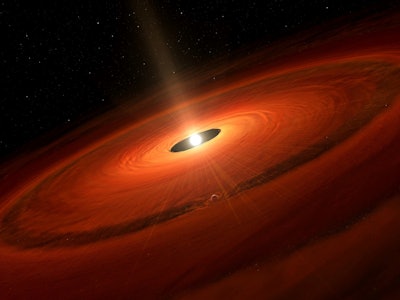The star TW Hydrae is like our very own time machine back to our own solar system’s formation. Located about 175 light-years from Earth — just down the street in cosmic terms — the star is estimated to be only about 10 million years old. That means it’s still very early in its lifespan, and a massive disc of dust and gas surrounds the star, providing the raw materials necessary for planetary formation. Here’s the best part: TW Hydrae and its disc are positioned relative to Earth so that we’re looking straight down on the entire system, giving us an absolutely perfect view of all that’s going on.
Astronomers have found multiple gaps in the disc that suggest a protoplanet is in the process of clearing out its orbit and accumulating mass — earlier this year, astronomers at the Atacama Large Millimeter/submillimeter Array (ALMA) in South America announced they had found a possible Earth-like planet at roughly the same distance the Earth is from the Sun. Now investigation of a second, much further gap in the disc has revealed another newborn planet orbiting TW Hydrae.
The planet would likely be Uranus- or Neptune-sized, and it’s located about 22 astronomical units — or 20 times the Earth’s distance from the Sun — from TW Hydrae. That’s just a little bit further out than Uranus is from the Sun, and it would likely be a massive icy giant like Uranus and Neptune. Astronomers used radio frequencies to estimate the sizes of the dust grains around the star. The gap in the disc appeared to have lots of smaller dust grains but lacking in larger ones, which is indicative of a planet that has begun sweeping its orbit clear. Knowing that ratio then allowed astronomers to predict the size of this new planet.
